#vodou quote
Explore tagged Tumblr posts
Text
Words To Live By

#conjuring#spiritual#like and/or reblog!#rootwork#voodoo#louisiana voodoo#Vodou quote#Quote of the day#Spiritual quote#follow my blog#southern magic#Magic quote
70 notes
·
View notes
Text
Narc
"I am available to provide information or quotes to media, law enforcement, governmental, or non-governmental organizations"
Really? Good to know you'll narc on anyone and their spiritual practices if there's a buck or exposure in it for you. Mate, law enforcement could conceivably come knocking at your door in a resurgent Satanic panic, but you, a white guy in the US, are publically admitting you'll give quotes to cops because you think Vodou is uniquely responsible for human trafficking in some way, and not that folks would, and do use any particular religious, spiritual or social belief or orthopraxy as a method of social control. Again: you, an American white guy, are publicly saying you'll talk to cops about an Afrodiasporic Religion's 'role' in modern slavery, a religion practiced by millions - the majority of whom are people of colour (but not all).
Look, it's obvious you had an intense magical and spiritual experience 20 years ago. You were loud enough then about how you were thrust into a world of what you described as hostile and dangerous spirits. You were loud enough about how you believed the problems of Haiti were down to the lwa as apparently insectile-iike beings that were larva - masks of dead and ancestral people being worn by Horrible Things. You were loud enough about how you believed they sucked the souls out of people: fed on fear, pain, and suffering. You were called out for your racism then. You are being so now, by others. You won't see this, but by all the gods that ever were, mate, of course modern slavery is a problem. But its not just Vodou. There's Christian-trafficking operations, Falun Gong trafficking, etc etc. You've had a massive magical experience that's inflated some ego biases and made either personal or cultural biases come roaring out and distorted your perceptions. That shit happens. One deals with it. One processes. Or one goes full on David Icke. I believe that you believe this. I know you won't see this as anti-blackness influencing you, that you are repeating colonial propaganda. That if anything got into you, it's cultural fear of a non-western spiritual ontology has been riding you for decades. And I also know you'll see this argument as being an apologia for enslavement - that I'm in denial. I'm not. As I have said, this stuff happens. But solely focusing on Vodou, your fervour inspired by a bad magical experience 20 years ago? That's fucked up. It truly is. And then, to set yourself up as an authority. To say you'll give quotes? To media. To governments. To NGOs. To cops.
You, who set yourself up as a teacher? Who has a website that has as its banner: Unleash Your True Self.
Master Magick, Master Your Reality.
A website with "thousands of video lessons on the core teachings of the world's sacred traditions. " We know you've appeared on media, worldwide. On podcasts. On sodding Netflix. Sure. Its your business. I wonder what'd happen if the police took all the data you have on your students? This isn't sour grapes - this is pure practicality here. What would happen if folks who were quietly practing magick were outed in a hostile environment But it's OK to give statements on Vodou and slavery to the powers that be. Isn't it? Because you're saving people. People can make their own judgments. Me? I view that as fundamentally untrustworthy. I wouldn't be happy placing my undoing of standard western materialism in such hands. Like I said, there's a word for that.
15 notes
·
View notes
Text


PORT-AU-PRINCE
Although I’d originally planned to style this character after Guede Nibo, I’ve since realized this was a misguided decision. He’s no longer based on Guede Nibo and is supposed to be a member of the Gede who does not exist in the real world.
A full discussion can be found in the middle of this description:
“Port-au-Prince” needs an updated description; I plan to do this at a later time.
Original, outdated description below cut:
RANTING ABOUT THE REAL-LIFE GEDE NIBO (GUEDE NIBO)

Andre Pierre featured Gede Nibo alongside Baron Samedi and Maman Brigitte in several paintings, such as “Les Trois Esprits du Cimetiere.”
Previously, I described Gede Nibo as (quote) “unapologetically queer”. Where did I get the audacity to make such a claim?
Well, there are a number of English language books and other sources that describe Gede Nibo himself as queer. As you may have gathered, I’m a big fan of Eziaku Atuama Nwokocha’s works, and have relied on her research. In Vodou en Vogue, Nwokocha describes him as an “effeminate dandy” who is “honored by queer people”. In Queering Black Atlantic Religions, Roberto Strongman also names Gede Nibo and Erzulie Freda as deities who "have strong associations with queer Vodou practitioners." Strongman’s statement is certainly true with respect to the Erzulies; the question is whether it is also true with respect to Gede Nibo.
Afraid of making the same mistake I did with Baron Samedi, I searched for a Haitian source, as there is a great amount of misinformation spread by English speaking, non-Haitians. Since the Haitian author Milo Marcelin also described Gede Nibo as queer, I stopped there and thought, “so Gede Nibo really is queer…!”
…But it seems I may have made the exact same mistake I did with Baron Samedi afterall.
OOPS!
As far as I can tell, the description of Gede Nibo as “queer” among English-speaking, non-Haitians originates in three major sources:
Gay, German author Hubert Fichte
Gay, American author Randy P. Conner
Haitian author Milo Marcelin
Hubert Fichte conducted his ethnographic work in Haiti during the 1970s. Apparently, Fichte heard Haitian farmers singing a song called “Masisi”, in which the lyrics went “Guede Nibo Masisi!”
He mentions the title of this song in Xango:
“Es gibt einen schwulen Totengott, Guede Nibo, und Anfang November singt das ganze Land, jeder haitianische Bauer die Hymnen auf die Schwulen - »Massissi« - und die ruralen Familienväter vollführen ambivalente Gesten vorne und hinten an ihrer Hose.”
Source: Fichte, Hubert, and Leonore Mau. 1984. Xango. Frankfurt: Fischer. p. 143 https://archive.org/details/xangodafroamerik0000fich/page/142/mode/2up?
An English translation is provided by Strongman:
“There is a gay god of death, Guédé Nibo, and in early November the whole country, every Haitian peasant, sings hymns to the gays— “masisi”—and rural family fathers perform ambivalent gestures at the front and back of their pants.”
Source: Strongman, Roberto. Queering Black Atlantic Religions: Transcorporeality in Candomblé (2019). p. 75
The lyrics of the song are described in Homosexualität und Literatur (Vol. 1):
“Als eine der wenigen Religionen verfuegt der Vaudou ueber eine homosexuelle Gottheit, den Totengott Guédé Nibo, und am Totensonntag singen die Vaudouglaeubigen in der Stadt und auf dem Land: Guédé Nibo Massissi, Guédé Nibo Massissi! – schwuler Guédé Nibo, schwuler Guédé Nibo!”
Source: Fichte, Hubert. Homosexualität und Literatur: Polemiken. Germany, S. Fischer, 1987. Vol. 1. p. 146
An English translation is provided in The Gay Critic:
“Voodoo is one of the few religions to espouse a homosexual divinity, the god of the dead Guédé Nibo, and on Dead Sunday the believers chant, throughout the city and in the countryside: Guédé Nibo Massissi! Guédé Nibo Massissi! – gay Guédé Nibo! gay Guédé Nibo!”
Source: Fichte, Hubert. 1996. The Gay Critic. Ann Arbor: University of Michigan Press. p. 118
Interestingly, Katherine Smith observed something similar in 2007, but the chant went “Gede Masisi!” not “Gede Nibo Masisi!”:
“Gede mounts individuals as well as small marauding bands of vagabon who may pound on tombs and yell obscenities at the dead. In 2007, one such group of young men dressed in drag, fellated bones, and danced flamboyantly as the crowed cheered “Gede Masisi!” (Gay Gede!).”
Source: Smith, Katherine. "Dialoging with the urban dead in Haiti." Southern Quarterly 47.4 (2010): p. 83
Hubert Fichte translated the word masisi as a schwul, meaning “gay”, but this is not accurate. Masisi is a slur that has been reclaimed by some within the Haitian LGBTQ community; really, la Communauté M / The M Community.
I have been using words that originate in the Western bourgeoisie, but these are not terms Haitians use to describe themselves - especially those oppressed by race and class. There are similarities between the word masisi and terms used in other non-Western cultures, such as hijra, bakla, okama, and fa'afafine.
As defined by Charlot Jeudy - the former president of KOURAJ who was killed in 2019:
“…the societal definition of masisi is ‘acting as the female partner in a homosexual relationship.’ You can have muscular, manly M persons, but for Haitians, they cannot be called masisi. The word masisi has always been an insult. It makes people uncomfortable for us to use it, but in Haitian Creole, there is no other way for me to describe what I am.”
Source: https://cornbreadandcremasse.wordpress.com/2013/06/16/the-m-community-lgbt-courage-in-haiti/
It’s from 2002, but the documentary Des hommes et dieux contains interviews of several self-identified masisi. Some who identify as masisi would probably identify as “gay” if they were born in America; others would probably identify as “trans” - either, as binary trans women, or nonbinary transfems. Either way, masisi is not synonymous with “gay” or “transfeminine”, and it is important to remember that it’s been used as hate speech.
Fichte was surely incorrect in using words like masisi, schwul, and gay to describe Gede Nibo. There is no doubt in his attraction to women. The question is whether he could be described as “bisexual”, miks, or if he is purely heterosexual - not queer in any respect.
Although he repeatedly describes Gede Nibo as “gay”, one of Fichte’s interviewees flatly denies this:
Ich frage:
—Ist Guédé Nibo Massissi? Schwul?
André antwortet:
—Das ist falsch. Die Götter, die aus zwei Teilen bestehen, sind keine starken Götter. Es sind gekaufte Götter. Man kauft die Götter, um Sachen zu machen, die nicht gut sind.
Source: Fichte, Hubert, and Leonore Mau. 1984. Xango. Frankfurt: Fischer. p. 182 https://archive.org/details/xangodafroamerik0000fich/page/182/mode/2up
Machine Translation:
I ask:
—Is Guédé Nibo masisi? Gay?
André answers:
—That is wrong. The gods that are made up of two parts are not strong gods. They are bought gods. People buy the gods to do things that are not good.
Because I do not speak German, I referred to Herbert Uerlings’ Poetiken der Interkulturalität for context:
Zu den gewichtigsten Ergebnissen seiner Feldforschung gehört, daß Guédé Nibo, einer der Totengötter, die alle traditionell mit Sexualität verbunden werden, ein Gott der Homo- und Bisexuellen ist. Sollte das zutreffen, so wäre es vermutlich eine neue ethnographische Erkenntnis über den Vaudou.47 Die weitergehende Frage an den Priester André, ob »Guédé Nibo Massissi« (X 182) sei, also schwul, wird verneint, aber auf eine Weise, bei der vor lauter offensichtlicher Abwehr Fichtes Vermutung praktisch bestätigt wird: »Das ist falsch. Die Götter, die aus zwei Teilen bestehen [bisexuell oder schwul sind — H.U.], sind keine starken Götter. Es sind gekaufte [schwache — H. U] Götter. Man kauft die Götter, um Sachen zu machen, die nicht gut sind« (X 182). Ein anderer, schwuler Priester dagegen sagt: »Es gibt Götter, die die Homosexuellen verachten, und andre, die sie lieben« (X 194).
Source: Uerlings, Herbert. Poetiken der Interkulturalität: Haiti bei Kleist, Seghers, Müller, Buch und Fichte. Vol. 92. Walter de Gruyter, 2013., p. 282
Machine Translation:
One of the most important findings of his field research is that Guédé Nibo, one of the gods of the dead, all of whom are traditionally associated with sexuality, is a god of homosexuals and bisexuals. If this is true, it would probably be a new ethnographic discovery about voodoo.47 The further question to the priest André as to whether "Guédé Nibo is Massissi" (X 182), i.e. gay, is answered in the negative, but in a way that practically confirms Fichte's assumption through sheer obvious defensiveness: "That is wrong. The gods who consist of two parts [bisexual or gay - H.U.] are not strong gods. They are bought [weak - H. U] gods. Gods are bought to do things that are not good" (X 182). Another, gay priest, on the other hand, says: "There are gods who despise homosexuals and others who love them" (X 194).
I do not know if Uerlings is correct in dismissing the interviewee as “defensive”, but I am grateful for his clarification of the phrase “aus zwei Teilen bestehen”.
Notably, the footnote on the same page states:
47 Ich habe in der Literatur keinen Beleg dafür gefunden. Allerdings notiert Deren zu Guédé: »Er vertauscht die Geschlechter und zieht Frauen Männerkleider und Männern Frauenkleider an« (Der Tanz des Himmels mit der Erde, 1992, S. 128f.), und vermerkt in einer Fußnote: »Es wird zwar selten eindeutig ausgesprochen, aber häufig finden sich Hinweise darauf. daß es sich bei Guedé [sic!] um eine hermaphroditische Gottheit handelt, genau wie Legba« (a.a.O.).
Source: Uerlings, Herbert. Poetiken der Interkulturalität: Haiti bei Kleist, Seghers, Müller, Buch und Fichte. Vol. 92. Walter de Gruyter, 2013., p. 282
Machine Translation:
47 I have found no evidence of this in the literature. However, Deren notes about Guédé: »He swaps the sexes and dresses women in men's clothes and men in women's clothes« (The Dance of Heaven and Earth, 1992, p. 128f.), and notes in a footnote: »Although it is rarely stated clearly, there are frequent indications that Guedé [sic!] is a hermaphroditic deity, just like Legba« (loc. cit.).
It is possible that the German Fichte was mistaken in describing Gede Nibo as queer, and that he mistook his lasciviousness for queer sexuality.
Notably, the Haitian author Milo Marcelin described Gede Nibo as queer in Mythologie Vodou (vol. 2): “Guédé Nibo, mystère mâle et femelle (hermaphrodite), est le protecteur des vivants et des morts.” Similar to the song “Masisi”, Marcelin describes another song that suggests Gede Nibo is himself queer. Naturally the song is sexually explicit, but you can find it in the source provided below, with one of the lyrics being “...Regarde la démarche de Guédé!”.
Source: Marcelin, Milo. Mythologie Vodou: Rite Arada. 2 vols. Port-au-Prince: Les Editions Haitiennes, 1950. Vol. 2, p. 181 & p. 187 https://www.google.com/books/edition/Mythologie_vodou_rite_arada/cjvXAAAAMAAJ?hl=en&gbpv=1&bsq=%22Regarde+la+d%C3%A9marche+de+Gu%C3%A9d%C3%A9%22
An English translation of this song can be found in: Conner, Randy P. Lundschien, and David Sparks. Queering Creole spiritual traditions: Lesbian, gay, bisexual, and transgender participation in African-inspired traditions in the Americas. Routledge, 2014, p. 63 https://books.google.com/books?id=5SINiF0fkqwC&pg=PA63&lpg=PA63
A large section of Conner’s Queering Creole Spiritual Traditions describes “homoerotic, pansexual, and transgender aspects” of Gede Nibo. (p. 94). However, one interviewee denies an association between Gede Nibo and queer sexuality - that being, the Caucasian Houngan Mark Alexander "Aboudja" Moellendorf (p. 64)
Source: Conner, Randy P. Lundschien, and David Sparks. Queering Creole spiritual traditions: Lesbian, gay, bisexual, and transgender participation in African-inspired traditions in the Americas. Routledge, 2014
Outside of the sources mentioned above, I have found little evidence that Gede Nibo is himself queer. Rather than Gede Nibo, I’ve found more evidence that the Erzulies are important to members of the aforementioned Haitian “M Community” (see bottom of this post). I have also seen claims that Gede Nibo sometimes cross dresses, but I’ve yet to find a reliable source for this. There are artistic renditions of him proudly displaying his sexuality, but I have yet to see any that show him in women’s clothing, or displaying queer sexuality.
It is possible that the authors listed above are correct in their assessment (except for Fichte, who was definitely wrong). However, there’s a lot of misinformation spread about the lwa outside of Haiti and New Orleans, which arises from foreigners misunderstanding the culture and traditions of Vodou. Since I have already made mistakes with Baron Samedi and Maman Brigitte, I could be wrong about Gede Nibo too. If this is the case, I apologize for spreading misinformation about him being queer.
It is also possible that the above was true at some point in the past, but not in the present. Afterall, Fichte and Marcelin wrote during the mid 20th century, and traditions evolve over time.
…Well, might as well start ranting about my Deviantart OC!
RANTING ABOUT MY DEVIANTART OC
This character’s name is “Port-au-Prince” - named after the capital of Haiti.
Unlike the real-life Gede Nibo, “Port-au-Prince” is just gay, and a drag queen. His personality and interests are similar to Angel Dust, where he is openly gay and flamboyant in his mannerisms. As it is a slur, I have been avoiding the word masisi, but it is likely he would identify as part of the “M community”. Where Alastor is (presumably) the son and/or grandson of New Orleans Voodoo Queen(s), “Port-au-Prince” is a houngan - an extremely powerful one at that. His appearance and personality were inspired by the individuals featured in the documentaries Des hommes et dieux and Paris is Burning.
I made this decision for these reasons:
To integrate him into the pre-existing world of Hazbin Hotel, as a counterpart Angel Dust
To represent the Haitian “M community”, who experience intense prejudice and violence, but find sanctuary in Vodou
To differentiate him from the real-life Gede Nibo
As a tribute to the association between the Gede and gender/sexual queerness
Here’s a list of sources to back this third point:
Nwokocha, Eziaku Atuama. Vodou en vogue: fashioning Black divinities in Haiti and the United States. UNC Press Books, 2023.
Conner, Randy P. Lundschien, and David Sparks. Queering Creole spiritual traditions: Lesbian, gay, bisexual, and transgender participation in African-inspired traditions in the Americas. Routledge, 2014
McAlister, Elizabeth A. "Love, sex, and gender embodied: The spirits of Haitian Vodou." Love, sex and gender in the world religions (2000): 129-146. https://africultures.com/love-sex-and-gender-embodied-the-spirits-of-haitian-vodou-5719
Smith, Katherine. "Dialoging with the urban dead in Haiti." Southern Quarterly 47.4 (2010): p. 83
Hence, the decision to make “Port-au-Prince” a queer drag queen.
As a counterpart to Angel Dust, he has a dual gangster-ballroom/voguing theme to him, where he runs his own ballroom house. Although his roots are from Haiti, I think it would be interesting if he was part of the diaspora, where spent much of his human life in New York. This too helps integrate him into the pre-established world, where many characters are former humans who lived during different time periods of American history. It also establishes another parallel between him and Angel Dust, who is also from New York. I was picturing his house as being a mix of Black transfems (more broadly, feminine of center AMABs) and Black transmascs (more broadly, masculine of center AFABs), who are all former humans. They also double as a battle force that could be recruited in a similar manner to the Cannibals in Cannibal Town, where they have strong healing and fighting abilities.
Port-au-Prince’s drag queen persona is inspired by Aaliyah as Queen of the Damned. In addition to Angel Dust, it would also be possible to establish a connection between him and Sally Mae, if she has any interest in drag. He is the adoptive son of the “Baron of the Dead” and “Gran Maman”, my other DeviantArt OCs who I drew here: https://www.deviantart.com/thegirlwhodidntsmile/art/Lavi-and-Lanmo-1073560801
This was inspired by the description provided by Roberto Strongman, where he writes:
“In Vodou lore, Gédé Nibo is a young man who was killed violently. Therefore, he has a particular association with those who die young. Once in the spirit realm, Bawon Samedi and Gran Brigit adopt him. In demeanor he is comical, lascivious, witty, and effeminate. In appearance, he is a dandy.”
Source: Strongman, Roberto. Queering Black Atlantic Religions: Transcorporeality in Candomblé (2019). p. 74
It would be imperative to run a concept like this by an expert on Haitian Vodou, to determine whether his portrayal is respectful or not. If it’s inoffensive, I think it would be cool if the three characters inspired by “Les Trois Esprits du Cimetiere” formed a “sexually complete” trinity: one male, one female, and one androgynous. But this may be problematic, as it could mislead audiences into thinking the real-life Gede Nibo is gay. Another approach would be to remove his drag queen persona, and make him a straight guy who has gay friends. Instead of Gede Nibo, the Erzulies could serve as inspiration for a character that embodies LGBTQ acceptance in Vodou.
RANTING ABOUT THE ERZULIES (EZILI DANTOR AND EZILI FREDA)
The Erzulies are important to the Haitian M Community - especially when accounting for race and class. Intense homophobia persists among the oppressed - who are denied access to higher education, and often understand sexuality/gender through religion. Those despised as masisi and madivin are tolerated in Vodou, where many houngans are themselves part of the M Community.
There is a fascinating documentary called Des hommes et dieux, which examines this very community. Several interviewees assert that Ezili Dantor has the power to make a person - male or female* - homosexual. It is for this reason that interviewees insist they were “born this way”, and that their parents - who might have otherwise rejected them - accept them as they are. I was particularly moved by statements from the interviewee Blondine, where the English captions read: “[My father] realized it came from voodoo. So he had to accept me. I’m like this because of the spirits that he’s serving. The loas decided I would be a girl. I was born this way.”
Granted, one interviewee (the houngan named Fritzner who self identifies as masisi) rejects this belief, considering it blasphemous. Either way, it is unanimous that the Erzulies protect the M community. Those hated as masisi are loved by the lwa, become their houngans, and are called les enfants d’Erzulie - “Ezili’s children”.
*I specify the category of sex, as the invisibility of “female masculinity” (including, masculine female homosexuality and the transmasculine spectrum) rears its ugly head. The “M Community” has language for transfems and feminine gay men; there are no equivalent terms for transmascs and masculine of center lesbians. As such, I have struggled to find information/research about the inverse phenomenon of “inverted” or “radically masculine” identifying members of “the feminine sex”; certainly not within the Black proletariat. Haiti is by no means unique in this regard. This disparity is found in many cultures all over the world - especially among the oppressed classes.
In any case, Erzulies are not just important to those of “the masculine sex”, but those of “the feminine sex” as well. Eziaku Nwokocha documents her personal experience as a Black queer femme with Ezili Dantor in The ‘Queerness’ of Ceremony. Zora Neale Hurston also briefly mentioned the importance of Ezili Freda to women who “tend toward the hermaphrodite” (i.e., with queer tendencies) in Tell My Horse. Unfortunately, I have struggled to find information about the Haitian equivalent of studs, aggressives, trans men, etc… due to the aforementioned issue of invisibility. Notably, none of the women at the temple Nwokocha visited were masculine-presenting, except for one visitor who dressed in red to honor the masculine lwa Ogou.
Previously I had been under the impression that Erzulie Dantor was associated with lesbians while Erzulie Freda was associated with the transfeminine spectrum. Just, a completely false dichotomy! WOW is there a lot of misinformation spread about Vodou! The Erzulies are associated with the transfeminine spectrum, as they protect femininity in all its manifestations. In addition to Black lesbians/bisexual/queer women, Erzulie Dantor is important to Black transfems, as she is depicted as a dark-skinned Black woman. That’s why people in the Haitian M Community love her, as a goddess of love, luck, and protection. For these reasons, I think it would be really cool to try to work Erzulie-inspired character(s) into this fictional world; granted, it presents more of a challenge to fit them into this setting, since they are not spirits of the dead. The easiest way to do so would be to have one of the Erzulies replace Mother Mary, if Mother Mary does not exist in the fictional mythology of Hazbin Hotel.
If you want to learn more about this, I highly recommend watching Anne Lescot & Laurence Magloire's documentary Of Men and Gods / Des hommes et dieux (2002). It’s available on Kanopy for free, and for rent Vimeo. Additionally, Eziaku Nwokocha, Roberto Strongman, and Omise'eke Natasha Tinsley have written several books and papers on this topic. Here are a few sources that can be accessed online:
Tinsley, Omise’eke Natasha. “Songs for Ezili: Vodou Epistemologies of (Trans) Gender.” Feminist Studies, vol. 37, no. 2, 2011, pp. 417–36. JSTOR, http://www.jstor.org/stable/23069911. Accessed 4 Aug. 2024.
Strongman, Roberto. "Cross-Gender Identifications in Vodou." In Defying Binarism: Gender Dynamics in Caribbean Literature and Culture. Virginia University Press. Ed. Maria Cristina Fumagalli. https://www.blackstudies.ucsb.edu/sites/secure.lsit.ucsb.edu.blks.d7/files/sitefiles/people/strongman/NewCrossGenderIdentificationsVodou.pdf
Nwokocha, Eziaku. “The ‘Queerness’ of Ceremony: Possession and Sacred Space in Haitian Religion.” Journal of Haitian Studies, vol. 25, no. 2, 2019, pp. 71–90. JSTOR, https://www.jstor.org/stable/26926664. Accessed 6 Aug. 2024. https://eziakunwokocha.com/wp-content/uploads/2022/11/The-Queerness-of-Ceremony.pdf
SIDE NOTE:
Rereading this, I fear I may come across as judgemental of writers like Fichte and Conner. That is not my intent! I do not think it is fair to judge these authors harshly. It is easy to take the internet for granted. I think these authors did the best they could with the technology that was available to them, but mistakes could have still been made. The fault does not lie on them, but myself for having been careless in my research.
#i actually tried to fit this character into the art style of the show... it's just a rough concept sketch but you get the idea#hazbin hotel oc#port au prince (hazbin hotel)#I wrote this sort of as a follow up to an earlier post where I didn’t have time to research LGBT rights in Haiti#the oppression and hatred of the M community is as intense as I thought it was. but it is remarkable how Vodou offers a space of tolerance#also for some reason I forgot to control for class and compared the bourgeoisie of Haiti against the underclasses of my#that was fucking stupid of me! why did I do that???
7 notes
·
View notes
Text
Well they shocked 😅
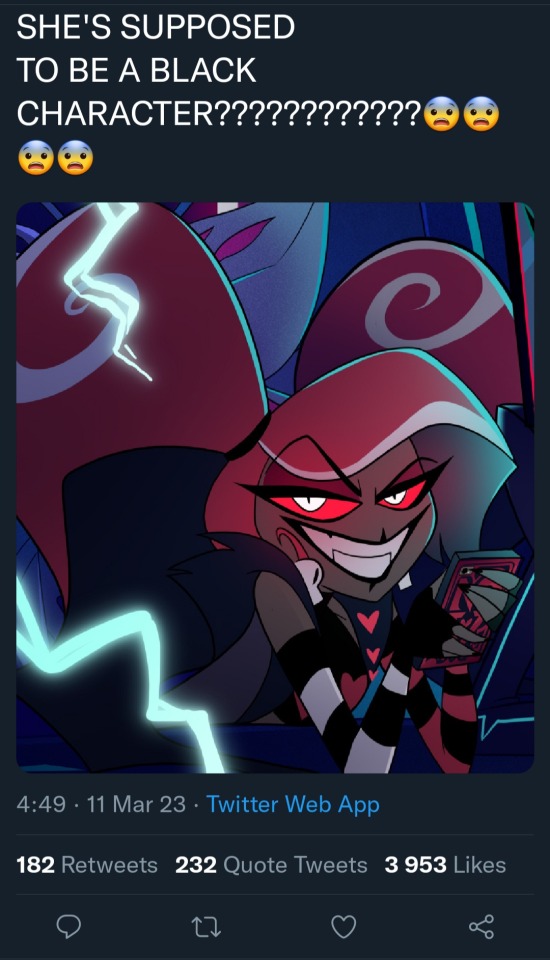
Wasn't surprised when people actually found out that Velvette is supposed to be a black woman I mean look at her. The quote tweets are not happy and its mostly poc so Viv you are not looking too good now... again Velvette is not even black coded at all I could not believe you at 1st glance that she is a black woman hah let alone 30 years old according to her leaked info because all of Viv's characters look like teenagers.


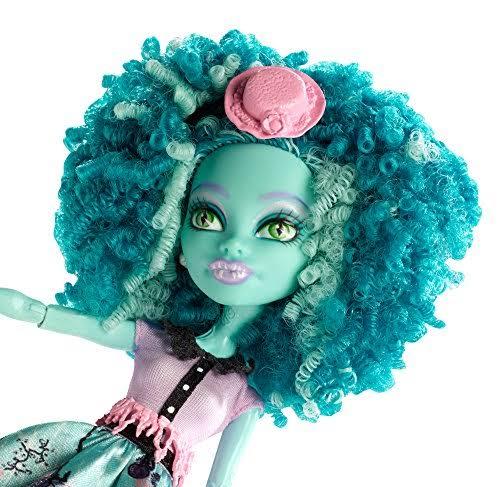
Like Velvette didn't even have to be... whatever "black" apparently skin tone she has (she's ashey af and its blatant erasure actually what they were trying with her skin tone) like I said black coded characters exist. Honey swamp is my all time favourite character and was a good example mentioned in the original tweet. Black coded not only in her design (her hair is everything) but also where she's from New Goreleans which is obviously a play on New Orleans. Could've had a voice actor to fit her but oh well but one gets the picture. Like the excuse of "of but she's a demon" 💀 Monster high gave us many poc coded characters that had all the colours of skin tones (not even mentioning the actual black characters like Clawdeen she was a werewolf but clearly black) but we knew they were poc because they were designed to be poc, the designers had that in mind and I do not see it in Velvette's design heck nore Alastor he was a white dude in his early design. Viv just looks like she slapped on him being creole because of the vodou and W-word debacle.

Whoo I fear hazbin coming out because this is shakey waters to be on before a show drops.
Small edit: the w word is in reference to a native American creature, the "wendy", hope the just of it comes across what I'm referring to. I won't type the full name out of respect.
#vivziepop critical#hazbin hotel critique#hazbin hotel critical#spindlehorse critical#Velvette critical#do poc characters justice Viv
71 notes
·
View notes
Text
Palo Mayombe: Kongo-derived Afro-Cuban Spirituality — Lawrence Talks!
“This complexity described in the Bantu-Kongo word for person, muntu is a ‘set of concrete social relationships ... a system of systems; the pattern of patterns in being.’ The person is contextualized as a system participating in other systems, a pattern, a ripple that is sourced and from a source.”
— Kimbwandende Kia Bunseki Fu-Kiau, African Cosmology 42
Dr. Kimbwandende Kia Bunseki Fu-Kiau, a Congolese native and scholar of African religion, captures the essence of Kongo cosmology with this quote, and from this cosmological structure lies the roots of the African diasporic religion Palo Mayombe. Just as a person is “a system of systems; the pattern of patterns in being,” ancestral reverence and inclusion positions humans through a multitude of bodies that have come before them. Ancestral veneration is at the core of many African Diasporic spiritualities. Many individuals who grew up in traditional Christian churches are leaving beliefs of Christendom in search for traditional religions that help them connect with their ancestors. Religious and spiritual systems like Ifa, Santeria, Vodou and Conjure have been popularized, sometimes in negative ways by the media, but for the most part these are the spiritualities that people turn to first in their exploration of African traditional religions (ATR). And what is known of Palo Mayombe by the general public is not a large amount of information by any chance. A Google search locates some articles which picture Palo as the “dark side” of Santeria, which is far from the truth. However, to understand Palo as a distinct spiritual system outside of other African diasporic religion, one must understand its BaKongo cosmological foundations.
History of ancient Kongo cosmology

Figure 1: Kongo cosmogram (dikenga)
Fortunately, there is a symbol that captures the essence of Kongo cosmology. The Kongo cosmogram is a cosmological symbol that represents the very patterning of the life process. This symbol is a pre-colonial representation of the cosmogram, as it was conceptualized before European colonization in 1482[1]. It is called the dikenga in the KiKongo language, literally meaning “the turning;” it stands for the cycling of the sun around four cardinal points: dawn, noon, sunset, and midnight when the sun is shining in the world of the dead. Composed of a cross, a circle, and usually arrows, this symbol was found in Kongo material culture well before the contact of colonial Christianity and its cross motif. Anthropologist Robert Farris Thompson, a scholar of Kongo art and religion, says that the “dikenga represents the ultimate graphic design, containing key concepts of Bakongo religious belief, oral history, cosmogony, and philosophy, and depicting in miniature the Bakongo conceptual world and universe” (Thompson 110). The key principle of the dikenga is that nothing ever survives “intact” because nothing ever survives in a fixed form. It is this spiral that is the basic element of Kongo spirituality.

Figure 2: Dikenga
In his seminal piece on Kongo cosmology entitled African Cosmology of the Bantu-Kongo: Principles of Life & Living, Dr. Fu-Kiau explains the motion of the dikenga as the process of ancestralization, of dying and being reborn as an ancestor, through the heating and cooling of existence. This explanation of death and ancestralization is at the core of Palo Mayombe.
Origins of Palo Mayombe
Palo Mayombe is a Kongo derived religion from the Bakongo Diaspora. This religion was transported to the Caribbean during the Spanish slave trade and sprouted in Cuba mostly and in some places in Puerto Rico in the 1500. As the enslaved were forced out of their homelands, their beliefs went with them. Spanish colonialists in Cuba initiated a strategy in the sixteenth century to create mutual aid societies, called cabildos or cofradías, which served to cluster Afro-Cubans into different ethnic categories. This was a strategy of “divide and rule” designed to foster social differences across groups within the enslaved population so that they would not find a unifying focus through which to rebel against the colonial government. In contrast to the extensive blending of diverse African cultures that would be seen in Haiti and Brazil, Cuban cabildos contributed to rich continuations of Yoruba culture in the development of Santería and to largely separate developments of BaKongo beliefs in Palo Mayombe (Fennel). Elements of Catholic beliefs were incorporated into both Santería and Palo Mayombe due to the imposition of the Spanish colonial regime and the cabildo system.
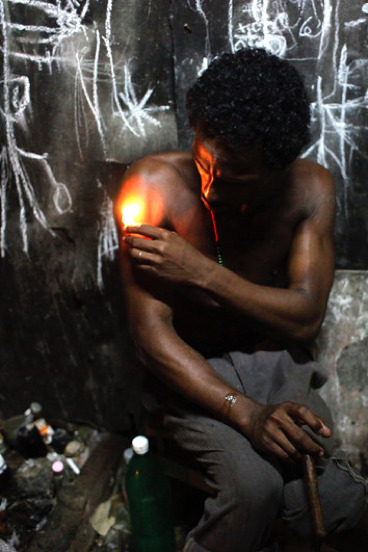
Figure 3 Palo Mayombe Ceremony
Palo Mayombe is very nature-based. Although most African Diasporic religions base rituals and practices in nature, palo (meaning “stick” or “segment of wood” in Spanish) solely depends on the material elements of nature to access the spiritual realm. In Cuba, the Kongo ancestor spirits are considered fierce, rebellious, and independent; they are on the “hot” scale of natural forces. Just as the importance of ancestralization mentioned above, the ancestors are present and inclusive in the practitioner’s life. Nzambi Mpungo is the greatest force in which paleros or paleras (Palo practitioners) call God. Nzambi Mpungo is literally the first ancestor, the initial iteration which all human life flows. Nzambi was viewed as having created the universe, people, spirits, transformative death, and the power of minkisi (ritualized, material objects). The Godhead was thus viewed as being removed from mortal concerns, and supplications were made instead to the ancestor spirits or the intermediary spirits created by Nzambi. Below Nzambi are the mpungus (elemental forces), the ancestors, and the spirits of natural forces (Bettelheim). Each mpungu is similar to an orisha from Yoruba culture due to shared African derived origins, but the two are not the same entity by any means. The mpungu are Afro-Cuban spirits, specific to their diasporic groundings and to the lands of the Diaspora. However, due to their origin
The material tools of Palo Mayombe
Cigars are used to enter into a trance-like state in order to more easily connect with spirits. Special machetes and chains are also used in spirit pots. Candles and rum are essential elements for any Palo ritual. The nganga is used to describe an iron cauldron filled with dirt and specialized sticks; this aids the palero/a in communication with the spirit. In Central America, Cuba and the Caribbean, this cauldron is called a Nganga-Prenda because the culture of modern day and the influence of Latin American's spiritualism in Palo Mayombe.
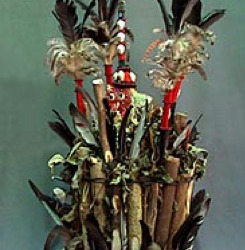
Figure 4: Prenda de Lucero
The Muertos are important entities in the Palo religion. The house of the dead is where the Palo spirits and the ancestors reside. As illustrated through the Kongo cosmogram above, Palo cosmology does not believe in death, but a continual cycle through various forms. It is the process of ancestralization that makes communication with the spirits of the dead accessible. In the Kongo tradition, ancestors, who have access to invisible forces, have the duty to protect the living. In exchange, the ancestor’s descendants have the obligation to take care of the ancestor’s memory and to venerate their earthly representation. This is why bones are another central tool in Palo. After a person has passed, the bones remain, and the bones carries the essence of a soul long after a person is gone. Bones are thus a sacred item in Palo Mayombe and are usually incorporated in Palo rituals. Usually an ancestor altar is an essential piece in the house of a palero/a, along with offerings of food, drink, and special itemize to venerate their ancestors.
Like many ATR’s and magical system, initiation of some kind is needed in order to practice. Guidance from the elders of the religion is highly encouraged, especially since the ways of the spiritual system is nothing like physical realms.
Palo Mayombe and Other Religious Connections
The influence of Palo Mayombe can be found in Central America, Brazil, and Mexico and in the United States. There are different sects of Palo (Palo Monte, Christian-based Palo, Jewish-based Palo) that come from different lineages and distinct engagements with the cultural environment around the practice. There is another Kongo-derived religion in Brazil is Quimbanda, which is a mixture of traditional Kongo, indigenous in India and Latin American spiritualism. Palo Mayombe is the engagement of Kongo influence in the Caribbean and the wider Diaspora. It has its own priesthood and set of rules and regulations. Rules and regulations will vary according to the Palo Mayombe house to which an individual has been initiated into.
Some people who practice Palo might mix other African-derived systems, like Ifa, Vodou, or Santeria, but Palo is a religion in its own right. For example, Yemoja, the orisha of the ocean and motherhood, may be seen as the same energy as Madre de Agua, the mpungo of the ocean and of motherhood. Although these spirits may have similar functions within the religions, they are two separate entites from particular cultural origins and with specific needs. It is quite common for spiritual seekers to be initiated in multiple religions, so it is of great importance to make sure each path is approached. Although there are other religious elements in Palo, it is all included in the practice and not separated within the religion. When Portuguese missionaries brought the message of Christianity to the Kongo/Bantu, the natives embraced it…while continuing their own native practices (Jason R. Young, Rituals of Resistance). So, this pattern of centripetal inclusion is also present in Palo Mayombe. As Iya TeeDee Oshún, a priestess of African diasporic religions, commented in a recent Facebook post:
“Palo is a beautiful road for those of us that it is for. It's also not just some shit you get done real quick before you ‘elevate’ because that's what Iya's spirit guide said to her in the shower. (Not making that up at all.) It's definitely not Iya nor Baba's "witchcraft pot" in the closet or behind the washing machine or above the grease stain in the garage. It's rarely what I hear when people talk to me in Yorabalese” (2019).
Iya’s mention of “Yorbalese” speaks to a common trend of people in the Diaspora making all of African-derived religions about orisha Ifa/Nigeria, but Palo is of the BaKongo Diaspora. The only system close in origin and practice to Palo is African American Hoodoo, which uses similar elements of the heating and cooling of herbs in spiritual work.
Conclusion
When one decides to take a step into the spirituality of Palo Mayombe, the journey really is a deep engagement with their ancestors and with the raw elemental forces of nature. It is a spiritual awareness that provides protection for the community and the self. The ancestors are the root of one’s existence; the root is the culminating point from which all life springs. This Afrocentric view of cosmology in which Palo Mayombe is grounded, deals with the consciousnesses of nature and of ancestry. Anyone who claims Palo Mayombe as a “dark” or unorthodox religion does not understand the Kongo origins of which Palo operates.
[1] The Kongo cosmogram is a pre-Christian symbol, but due to the iconography of the Christian cross, many people overlap their meanings
#Palo Mayombe Kongo-derived Afro-Cuban Spirituality#Palo#ATR#Congo#African Cosmology#Ancestry#African Religions#IFA#Palo Monte#Kongo
6 notes
·
View notes
Text
Queen in 5 Minutes — VoicePlay music video
youtube
The late, great Freddie Mercury is often quoted as having said, "Do anything you want with my music, but never make me boring." VoicePlay certainly took that sentiment to heart for this medley of memorable Queen songs, as well as the dramatic visual tale they made to go along with it. A battle for Earl's (after)life plays out in a suitably theatrical setting. Who will win?
Details:
title: Queen in 5 Minutes
original songs / performers: all songs by Queen — "Bohemian Rhapsody"; [0:32] "Play The Game"; [0:54] "Somebody To Love"; [1:20] "We Are The Champions"; [2:20] "Another One Bites The Dust"; [2:37] "We Will Rock You"; [2:45] "Under Pressure" with David Bowie; [2:52] "I Want to Break Free"; [3:14] "Good Old-Fashioned Lover Boy"; [3:32] "Play the Game" reprise; [3:48] "Bohemian Rhapsody" reprise; [4:16] "Radio Ga Ga"; [4:21] "The Show Must Go On"; [4:45] "Don't Stop Me Now"
written by: "Bohemian Rhapsody", "Play The Game", "Somebody To Love", & "We Are The Champions" by Freddie Mercury; "Another One Bites The Dust" by John Deacon; "We Will Rock You" by Brian May; "Under Pressure" by Queen & David Bowie; "I Want to Break Free" by John Deacon; "Good Old-Fashioned Lover Boy" by Freddie Mercury; "Radio Ga Ga" by Roger Taylor; "The Show Must Go On" by Brian May; "Don't Stop Me Now" by Freddie Mercury
arranged by: Layne Stein & Eli Jacobson
release date: 23 November 2018
My favorite bits:
recreating that iconic Bohemian Rhapsody intro
J.None's fantastic control, flipping between chest and head voice as he extracts Earl's heart 🫀 ⚖️
that smooth scoop from Earl on ⇗ ♫ "take a loooOOOK" ♫ ⇗
Geoff going full Chris Cornell at the start of "We Are the Champions" before dropping back into the underworld
J.None shoving the sword into Layne's hands to get him more involved as he sings about ♫ "fighting til the end" ♫
Eli's busting out that rock grit for "We Will Rock You"
Layne beatboxing the iconic stomp-stomp-clap rhythm rather than breaking viewers' immersion in the scene
Earl repelling everyone through the power of belting
the dismissive face Geoff makes at Eli as he continues the "Under Pressure" bass line into "I Want to Break Free" (a more serious take on the "Ice Ice Baby" bit from their "Old School Rap" medley)
Earl's plaintive vulnerability during "Lover Boy" solidifying into defiance for the return to "Bohemian Rhapsody"
the backing vocals pleading with Earl to ♫ "play the game" ♫ so they can guide him onward
ramping up into full concert mode as they form a line at the front of their "stage"
high tenor air guitar! 🎸
Eli and J's subtle counterpoint line from "Radio Ga Ga"
using "The Show Must Go On" to signal Earl's decision to return to the world of the living
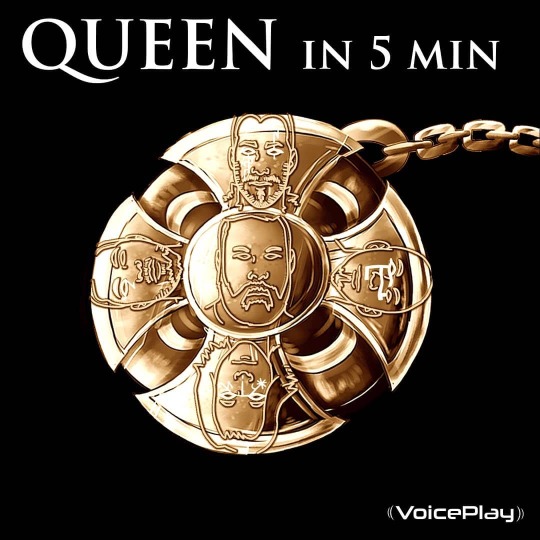
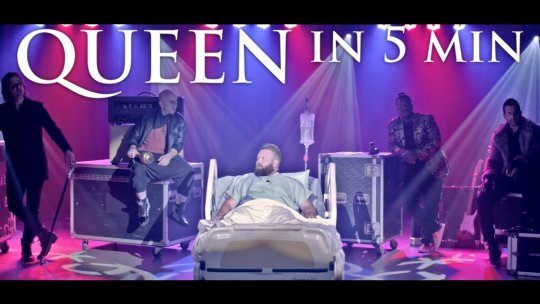




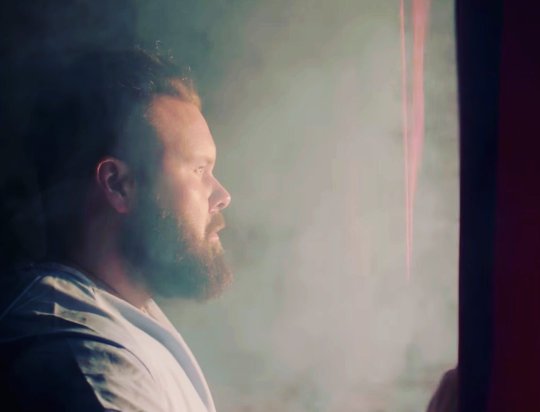
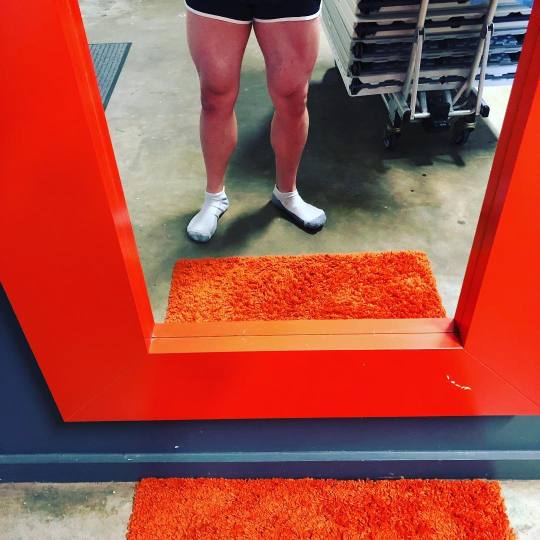
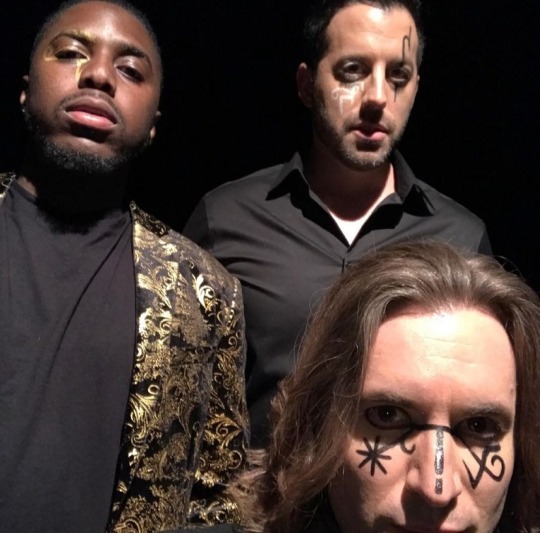
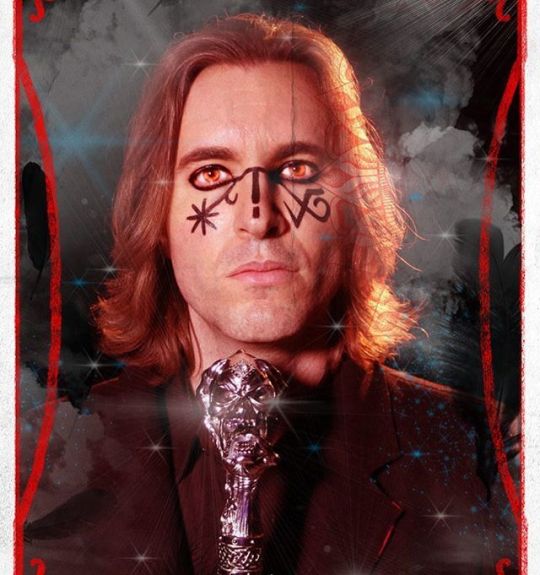
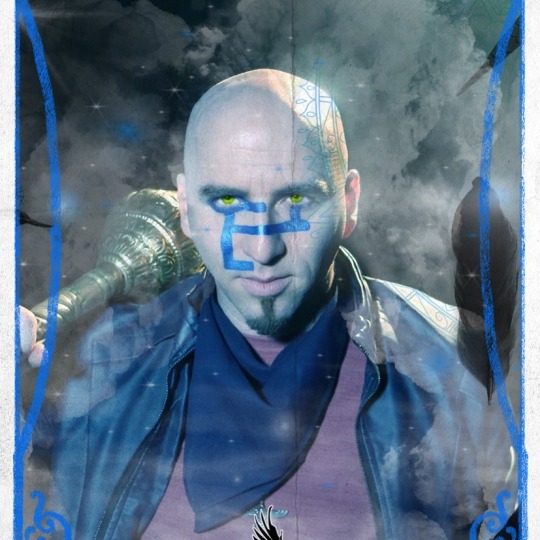
Trivia:
○ The man in the hospital framing scenes is Earl's husband, Nick. He has appeared on screen in a few VoicePlay videos, as well as doing production work on many more.
○ The four avatars of death come from various religious traditions:
Guardian (Layne) is an anthropomorphized version of Cerberus from Greek mythology, the multi-headed hound (hence the fur coat) who protects the gates of Hades.
Anubis (J.None) is the guardian of the dead and assessor of souls in the Egyptian pantheon, often depicted as a jackal.
Yama Nirvana (Eli) represents the Hindu god Yama, responsible for death, justice, and punishment of sinners in the afterlife.
Baron (Geoff) is an interpretation of the spirit Baron Samedi, master of the dead and resurrection in Haitian Vodou.
○ The guys' distinctive makeup and wardrobe were designed by artist Leon King. Of the four, J.None's costume changed the most from concept to execution, but each of them was tweaked a bit.

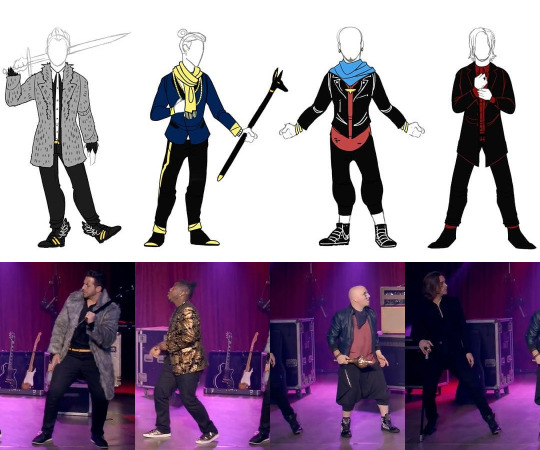
○ Leon also drew the central pendant element for the cover art.
○ The YouTube description includes the inscription, "We humbly dedicate this video to the music and memory of Freddie Mercury. The show must go on."
○ Some fans have embraced a headcanon that this video is a sequel to "Panic! in 4 Minutes". They theorize that Earl is in the hopital because he was injured by the explosion, and the avatars of death are manifesting as his bandmates within his unconscious mind. This hasn't been confirmed or denied by any members of VoicePlay, but it's a fun idea.
○ This video reached a million views on YouTube the following August.
○ The streaming audio version is split into two parts, "The Arrival" and "The Return", with the divide falling between "I Want To Break Free" and "Good Old-Fashioned Lover Boy".
○ The complete track was later included on VoicePlay's "Citrus" album, which compiled most of the songs they recorded from 2017-19. Because the individual songs had already been made available digitally, that album is exclusively a physical item that can only be purchased at live shows or through their website.
6 notes
·
View notes
Text
So I Wanna Talk Vodou in Castlevania: Nocturne But First...
We gotta talk about Magic in Castlevania as a whole. The problem though is that there's not much new to say that one can't grasp from watching the show and being exposed to other media which includes magic (which is like what? 99% of all fantasy fiction?). The show doesn't go out of its way to explain anything about how magic works but then again what is there that needs explaining? Pretty brown lady does some finger stuff and something goes boom or sparky, a couple of guys can raise the dead, something something levitating sword, something something magic portals, something something something something magic exists, just deal with it. What seems to be of interest to the show is how magic is used by each character and what that says about them, their roles in the story, and their arcs.
Sypha, for example, is the powerhouse of the main trio boasting the most diverse and deadliest set of abilities since her magic consists of control over fire, water/ice, and lighting. This has led her to be key to some of the team's wins over various vampires, creatures, or even humans. While Trevor may struggle with one enemy, she could be handling several at once. This dynamic is most evident during the fight with Dracula as Daddy Drac could handle his son and a Belmont but Sypha was a wildcard that he knew he would have trouble. Even if you can argue that by herself she could never beat Dracula, her presence was the edge that the trio needed. But what does that say about her? She's adventure- loving, brave, and her knowledge as a speaker gives her insight where Trevor's experience and Alucard's vampiric and scientific knowledge might fail them. However, none of this is more important, I think, than her role as the "heart" of the team. Trevor and Alucard are cynics held back by their respective familial traumas to see the world for what it is, she provides optimism and love for life and humanity that both lacked and this aspect of her character enabled them to think in ways they weren't able to before. Like her magic, she's able to take the elements of those she loves and make them into something more powerful than what they seem capable of. Get it?
You can basically extend this analysis to most of the cast. Nothing entirely too deep either for people whose hobbies involve over-thinking about the stuff they watch. You see, my thing is magic in most fiction isn't really... magic and that has some bad implications for Annette's Vodou in Nocturne. Why? Because it's basically just science when physics is weird and wonky. That's not even off brand for it either, we all know that one quote about advanced enough science being indistinguishable from magic but even before this quote some Italian guy name Giovanni Pico della Mirandola said that magic was the practical application of natural science. The video I reblogged of the guy moving a crowd of bugs from the light in his yard to the streetlight is absolutely magical... but pretty easy to explain using bug psychology. Hell some scientists go out of their way to find miracles from various faiths (mainly Christian though) and try to explain them just for funsies (or apologetics) to stretch the limits of what science can explain and what it can't. This is all well and good for a view of magic that is centered around the idea of it being manipulation of phenomena but it kind of runs against other perspectives that see magic and adjacent activities as more than just phenomena. Take, for example, the existence of deities. If there is a fire god, what is fire magic? Does the magic come from the god? Do you need to have a special connection with the god to do the magic? Is it possible to become a fire god if you're powerful enough or is there something more to the title? What separates what the god does from the magic a human performs? If not a god, what about a fire spirit? Is there a difference between a spirit and a god? Do spirits take on the form of the element itself or are they separate from it? Notice how me adding in the element of a conscious thinking entity now muddies the waters a bit. Now what would be a simple "application of science" is now a question of relationships between two persons.
Let's apply this back to Sypha. Sypha's magic is manipulation of fire, lighting, and water. Assuming that elemental spirits/deities exist, how did she acquire such skills? Does she pray to them, bargain with them, worship them? Is there a ritual involved that she has to perform? It's a bit of a headscratcher if we think on it but I don't believe that she's dealing with any external entities with her magic and I'm certain the writers intended for her magic to be as straight-forward as it appears. And notice how the other magic in the show fit a similar simplistic "mold"? Alchemy and Forgemastery are basically in the same "do a thing then a thing happens" territory that Sypha's elemental kinesis fits in. But just like how adding in a "second party" into the mix of the magic throws a kink in how we're supposed to perceive Sypha's magic, doing so for Alchemy and Forgemastery does the same. In fact, Alchemy stops being Alchemy the moment you start adding in cosmic beings because it practically ruins the point of alchemical work. So in a world where all the magic is connected together by a common "science-y" theme to it all that's supposed to enable us to shut off our brains and just accept said magic without explanation because we trust that there is one, how do you fit magic where entities are a part of how everything works? And when the magic you're introducing is from a faith that's been demonized to hell and back, how do you make it fit into your world with good representation? Well, for Nocturne, the answer is not terribly but not all that good either...
#castlevania netflix#castlevania nocturne#castlevania anime#sypha belnades#magic#annette castlevania
12 notes
·
View notes
Text
Book Review: New World Witchery
New World Witchery : a Trove of North American Folk Magic - Cory Thomas Hutcheson. Llewellyn Publications, 2021. English.

★★★★ (4/5) This book has as many flaws as reasons to adore it, and so this may prove to be a very lengthy review. TL;DR: at the bottom.
Picking this up in the bookstore I was very excited. Hailing originally from Europe, now living in Alaska, and practicing primarily European folk magic, this seemed like a fantastic book to bury myself in and learn about folk magic of my new home continent. Delving into it I was immediately captivated. The structure of the book is very very creative, and the way the author writes really takes you away. I appreciate the inclusion of not just theoretical material, which may fall flat to the reader due to a number of factors, but also biographies of magical practitioners and the sections that encourage you to apply what you read in real life. That said, as an experienced practitioner holding the 'worksheets' up to my own work, it felt a tad empty. The author, though very good at relaying folkmagical tradition, doesn't impart a lot of folk magic's cosmology or quasi-scientific historical approach into the recommended rituals. This has benefits and drawbacks. I think that for an experienced practitioner that sticks to folkmagical principles and a set cosmology, the recommended magical practice is next to useless. However, a beginner practitioner, or somebody looking for direction and inspiration, may find a wealth of new ideas in these sections.
Of course there are the necessary socio-political issues to consider in a book review. I would not discount this book on this account, but I have a few notes. The author undeniably covers his bases. He explicitly warns against the drawbacks of such an extensive piece of literature, of it also including hoodoo, vodou, root working, jewish, native, etc practices. He makes a strong statement against appropriation. But I am a nitpicker, was born one, unfortunately. Some things I noticed: The author does recommend using both 'sage' and palo santo during the worksheet sections a few times. While he takes a stance against appropriatively using materials and rituals, I think it could use a bit more stressing that these plants (salvia officinalis and sandalwood) are endangered or close to it and shouldn't be used by people unable to obtain and use sustainably. The author recommends offering tobacco to ancestors, tobacco being a topic of hot debate presently as to whether or not the use of it in ritual should be reserved for Native American peoples. The author refers to his own magic as 'mojo' once and seems to use Hoodoo tradition fairly freely. Take that as you will. The author started the book off very very careful not to call Native Americans the I-word unless directly quoting something, but appeared to get more casual about that toward the end. Author refers to both mythical witch gatherings and real life festivals a 'witch's sabbat(s)', something I consider to be antisemitic. Author recommends taking a volunteering job cleaning graves to collect graveyard dirt without breaking any laws. Dubious? All that said - I can't knock the book for any of this. The information is good, and the book is well written. Ultimately we can never expect to agree on socio-political progression all the way with one another, and the author seems conscious about liberation for all and respectfully applying his knowledge of various traditions.
The bibliography is good, with only a few eyesores. For this section I ought to explicitly mention I have something that could rightly be referred to as a personal vendetta with Western Esotericism and its derivatives, which is why I react to certain types of modern magic as though I were allergic. All of the 'negatives' I'm about to outline are purely subjective and based on my irrelevant ass opinion. The author occasionally references and appears to hold in high regard such authors as Judika Illes and Scott Cunningham, who are undeniably primarily Wiccan authors, or at the least authors geared toward contemporary practitioners, not folk practitoners. The likes that spell it 'magick'. I should also mention that while the author takes a very neutral stance on Traditional Witchcraft (this in reference to Wicca and the like), he does include such things as the Rede and the Wheel of the Year, which he dubs "deeply agricultural." I just had to bite my tongue and keep reading.
Finally I would like to note that the book, though it refers to itself as about all of North America, pretty much only covers the Atlantic half of North America. In fact, I believe the West Coast only gets mentioned in passing twice, both times when offhandedly mentioning Bigfoot/Sasquatch. This makes sense, on the one hand: the richest folk-magical traditions are there. But on the other: the West Coast, though lacking in such big communities of traditional practitioners, has a rich history of spirituality and magic as well, mostly from the Native peoples here and, in Alaska, from Russian colonists. If the book didn't also discuss Native traditions of the East Coast and Midwest, I wouldn't be salty. But it does, and I would've liked to see a bit more discussion of the West and the Arctic. It would've fit in!
All of that said, I thoroughly enjoyed this book. It certainly isn't the type of work you're supposed to read front to back over the course of a few days, but that is exactly what I did and I still liked it! I think the information presented is overall very good, and should be held up to light only as much as any other source should be. Cross-reference, kids! Something I noticed as I worked my way through is that this book would lend itself exceedingly well to being used as a textbook, due to its structure. I wouldn't recommend this book to an ultimate, bare-bones beginner who has no idea how to research and what to look out for yet, and I wouldn't recommend this book to an already very experienced practitioner looking to truly severely deepen their knowledge. But I would recommend this book to a team of them - an advanced mentor able to use this book as a textbook for a student, capable of helping them discern between appropriate and inappropriate conduct, and giving them direction in their early stages. TL;DR: This is a great book. Cross-reference as you would with any other resource, and be sure to contemplate your own ethics and what heritage you are and are not entitled to. I would recommend this book to: - Mentors teaching beginners; - Novice practitioners with some pre-existing knowledge, that are confident in their abilities to cross-reference; - Practitioners in need of some direction or inspiration; - Practitioners that have a hard time finding magic in their native surroundings. Maybe pass on this book if you are... ... from the West Coast and only interested in the West Coast; ... not confident in your ability to cross-reference; ... a true beginner with little to no pre-existing knowledge and cosmology; ... a well-established North American folk practitioner looking for a deep inquiry into the nitty gritty of New World folk magic; ... unaware of appropriate conduct and social issues in the magical community.
2 notes
·
View notes
Text
How a Voodoo Magic Specialist Can Help You Accomplish Your Goals?
When achieving our goals, we often seek assistance from various sources. From motivational quotes to guides to motivate us, we discover diverse paths to attain success and remove our stumbling blocks. However, visiting a renowned specialist in voodoo magic in Melbourne can also help you when you need the most. Voodoo, rooted in ancient African traditions, is a spiritual practice that helps people manifest their desires. In this blog, we will explore how a voodoo magic specialist can be instrumental in helping you reach your objectives in life.

What is Voodoo Magic?
Voodoo, also known as Vodou or Vodun, is a religious and spiritual practice rooted in Africa. It encompasses diverse beliefs and rituals connecting with deities, spirits, and ancestors. Voodoo practitioners believe that the spiritual realm can impact the world around us, and by channelizing this power, they can bring positivity to their lives.
Harnessing the Power of Intention
One of the fundamental aspects of voodoo magic is setting clear intentions. An expert practicing it can guide you in articulating your goals with utmost clarity. Helping you identify your desires and understand the underlying motivations enables you to establish a strong foundation for your journey towards success. Setting intentions is crucial as it aligns your conscious and subconscious mind, paving the way for focused and determined action.
Rituals and Spellcasting
Voodoo magic practitioners employ rituals and spellcasting to manifest desires. They establish a connection with the spiritual realm through specific ceremonies and offerings.
A specialist in it such as African Psychic Mr Abraham possesses the knowledge and experience to design and perform rituals tailored to your goals. Whether attracting love, improving financial prospects, or enhancing personal growth, they have the expertise to create and execute practices that align with your aspirations.
Harnessing the Power of Energy
The ritual recognizes the importance of energy in achieving goals. A voodoo magic specialist understands the intricate workings of power and can help you harness it to your advantage.
They can provide you with techniques and rituals to clear negative energy, enhance positive energy, and create an environment conducive to realizing your goals. By working with you to balance and channel your energy, they empower you to achieve optimal results.
Overcoming Obstacles and Challenges
The path to success is often filled with obstacles and challenges. A voodoo magic specialist can assist you in navigating these roadblocks by offering spiritual guidance and protection.
They can identify potential hurdles and provide remedies to overcome them through their expertise. They may perform rituals or prescribe specific talismans to give you the strength and resilience to surmount obstacles on your journey.
Enhancing Personal Growth and Confidence
In addition to aiding you progress towards your goals, a voodoo magic specialist can contribute to your overall personal growth. Their spiritual guidance and support can help you develop self-awareness, self-confidence, and self-belief.
They may offer practices that align with your goals, such as meditation or affirmations, to promote a positive frame of mind and enhance your chances of becoming successful in all spheres of life.
Voodoo offers a unique perspective rooted in ancient spiritual traditions in a world filled with diverse approaches to achieving goals. A specialist can be a valuable ally on your journey to success, assisting you in setting clear intentions, performing rituals, harnessing energy, overcoming obstacles, and fostering personal growth. However, it's important to approach voodoo magic with respect and understanding, recognizing that it is a deeply rooted practice with cultural significance.Remember that voodoo is not rocket science that instantly brings success, so you must be patient. The practice can enhance your efforts and strengthen your resolve when used wisely and ethically. If you want to transform your life for the better, contact African Psychic Mr Abraham, the leading voodoo magic specialist in Melbourne.
2 notes
·
View notes
Text
The Respect.

#new orleans voodoo#haitian vodou#Voodoo priest#original art#digital art#Voodoo sign#spiritual quote#like and/or reblog!#follow my blog#ask me anything#traditional rootwork#google search#vodou quote#voodoo quote#daily qoute
5 notes
·
View notes
Text
Mama Lola
Mama Lola: a Vodou Priestess in Brooklyn is a biography of Haitian born priestess Marie Thérèse Alourdes Macena Champagne Lovinski, better known as Mama Lola, by anthropologist Karen McCarthy Brown, turning Mama Lola into the most famous Vodou priestess in America. First published in 1991, Karen McCarthy Brown’s biography of Mama Lola’s life and family lineage, beginning with her great-great-grandfather Joseph Binbin Mauvant, acts also as a cultural and religious history of Haiti, Vodou practices, and the Haitian immigrant experience to the United States. They met in the summer of 1978 when Karen Brown was working for the Brooklyn Museum on a survey of the local Haitian immigrant community (1).
Arguably anthropologist Karen Brown approached Caribbean history with a gendered feminist lens, an approach that had been done before to Latin American history with Ann Pescatello with her article “The Female in Ibero-America,” in the Latin American Research Review in 1972, and the essay collection Health and Healing in the Early Modern Iberian World. Gendered history of Haiti was still a new approach for Haitian historians and anthropologists at the time Karen Brown’s book was published in 1991, even though women have played a part in Haitian history since before the revolution, an aspect delved into by modern historians like Philippe Girard in his 2011 book The Slaves Who Defeated Napoleon and “Rebelles with a Cause: Women in the Haitian War of Independence, 1802-1804,” for Gender & History in 2009.
The past books we’ve read delved into African healing approached as a more scientific history, like Pablo Gómez’s The Experiential Caribbean, or narrative like James Sweet’s book on Domingos Álvares. Here with Karen Brown’s book our class had finally read a work that approached African healing, as a religion, comparing aspects of Haitian Vodou to Catholicism, noting how the lwa are often called saints despite not being traditionally saintly (6). As a more anthropological work, Dr. Brown’s book had a more similar methodology with Clifford Geertz, than Jacob Burckhardt, quoting Ms. Alourdes heavily throughout the book, aiming to tell Mama Lola’s story and refute the negative stereotypes of Haitian Vodou (14-15).
In Chapter One we learn about Mama Lola’s great-great grandfather Joseph Binbin Mauvant in Jean Rabel, his daughter Marie Noelsine and her granddaughter Philomise, Marie Alourdes’s mother (26-27). Chapter Two was dedicated to one of the lwa spirits that influenced Mama Lola the most, Azaka Méde, also known as Papa Zaka, and the connection Mama Lola stated to have, describing the work Marie Alourdes had fashioned to celebrate the spirit’s birthday when Dr. Brown visited her, including an altar (36, 40-42). Chapter Three was dedicated to Alourdes’s grandfather Alphonse Macena and the relationship with her great grandmother Marie “Sina” Noelsine (84).
Chapter Four was dedicated to the warrior spirit Ogou with brief mentions of other spirits like Ibo, and the connection to Haitian politics; the later half of this chapter is dedicated to a vodou marriage Karen Brown went through to the spirit Ogou (100, 134-138). Chapter Five was dedicated to the baka, evil incarnate spirits, and the baka summoned out of jealousy to Mama Lola’s grandmother Elsa Fouchard, separating her from her daughter Philo, but leading Philosmise into becoming a Vodou Priestess herself (142-143, 153-154). Chapter Six used Mama Lola’s story to showcase the spirit Kouzinn, the female counterpart to Azaka and one Alourdes did not cite a Catholic counterpart (156).
Chapter Seven Philosmise formed a friendship with pharmacist Clement Rapelle, him asking her to treat his son in the Haitian tradition and he bought the medicine Philo needed after she gave birth to Mama Lola (205, 213). In Chapter Eight, Mama Lola explained to Dr. Brown the female spirit group, the Ezili (222-223). Chapter Nine delved more towards Mama Lola’s present, showcasing the conversations Dr. Brown had with Marie Alourdes, especially the ones over Mama Lola’s daughter Maggie and how Alourdes really wants Maggie to get married than to follow in her footsteps (263-264).
With Chapter Ten Dr. Brown to Danbala and the Haitian rituals performed in New York (272, 281). In Chapter Eleven Dr. Brown again dedicated a chapter to watching Mama Lola’s religious practice one Sunday and the conversations Karen had with Mama Lola, her second-level helper Robert Gerard, and her daughter Maggie (313-320). The final chapter, Chapter Twelve, was dedicated to the Vodou spirit of death, Gede; Mama Lola also admitted that she is also Christian, telling a story of a time she turned down a customer away for being a paying member of a satanic group, saying “Satan is more powerful than me,” (330, 337).
Overall, religious anthropologist Karen McCarthy Brown, had created an interesting approach to Vodou history that still primarily focused on Mama Lola, and her family lineage, not delving out too much into Haitian history and the Vodou religion the way Dr. Sweet’s biography of Domingos Álvares did. Although that was likely to happen when your “subject” is still alive and became a lifelong friend. I also appreciate how Karen Brown avoided otherizing the Vodou religion, even participating in a spiritual marriage with the lwa spirit Ogou.
1 note
·
View note
Text
RE: Is the actual Baron Samedi sometimes portrayed as bisexual in Haitian Vodou?
Unlike my previous posts, this one is about the actual deity, Baron Samedi.
Previously I had claimed that the actual Baron Samedi is portrayed as bisexual (and a vers) in some places in the world. Upon further investigation, this claim is dubious. I have learned the hard way that books and the web are often unreliable sources of information when it comes to Vodou / Voodoo.
On Wikipedia, there is a claim that Baron Samedi is portrayed as bisexual in Haitian Vodou:
Gede Nibo's parents are Baron Samedi and Maman Brigitte; Baron Samedi is the leader of the Gede and Barons and is depicted as bisexual dandy or occasionally cross-dressing, wearing a top-hat and frock coat along with a woman's skirt and shoes. Samedi has a tendency toward "lascivious movements" that cross gender boundaries and also imply a lust for anal sex.[14]
The source for this claim is from a book written by Randy P. Conner, titled Queering Creole Spiritual Traditions.
There is an image posted on this Wikipedia article, captioned “Depiction of Baron Samedi, a bisexual lwa.” This image is dated from year 2006, taken from the Island of Salvation Botanica in New Orleans. This botanica is owned by Sallie Ann Glassman, “one of few white Americans to have been ordained [into Vodou] via the traditional Haitian initiation.”
I am not entirely certain of this, but it seems likely that both Conner and Glassman have confused Baron Samedi with one of the Gede.
Baron Samedi is probably the single most iconic lwa associated with New Orleans Voodoo. This is ironic, as I have been unable to find evidence that he was actually worshiped in New Orleans prior to the revitalization movement. The revitalization movement of the late 20th century draws heavily from Haitian Vodou. It has been criticized by Haitians for bastardizing their traditions and deities. One of the most common errors is the conflation of Baron Samedi with a different category of deities, called the Gede.
As far as I can tell, there are three sources which claim that Baron Samedi is portrayed as bisexual and/or gender-blending. These sources are Randy P. Conner, Katherine Dunham, and Zora Neale Hurston.
Randy P. Conner is a gay, Caucasian American academic, described as “an initiate and practitioner of both Haitian Vodou and Reglade Ocho (Santeria), studying primarily with Mama Lola, a well-known practitioner of these African Diasporic traditions.”
The following is a quote from Conner’s Queering Creole Spiritual Traditions (2014):
Sanmdi is a bisexual and occasionally androgynous dandy, leader of both the Bawons and the Gedes and the spirits of the dead. Married to Maman Brijit, he is the father of Gede Nibo…The Bawon is well known for his lascivious movements, which include both phallic thrusts and pelvic grinds, the latter (and perhaps also the former) indicating a desire to engage in anal intercourse.
A similar quote can be found in Conner’s Cassell’s Encyclopedia of Queer Myth, Symbol, and Spirit (1997):
Baron Samedi (also Baron Cimitiére, Baron La Croix) in Haitian- and New Orleans-based Vodou, a bisexual and occasionally transgendered dandy, leader of the Barons and the GHEDES, the spirits of the dead. He is married to Maman (or Madame) Brigitte (also known as Gran-N. Brigit)...The Baron is well known for his “lascivious movements,” which include both phallic thrusts and pelvic grinds, the latter (and perhaps also the former) indicating a desire to engage in anal intercourse.
Katherine Dunham was a famous African American dancer and social activist, known for studying dance forms within Haitian Vodou. The following is a quote from Dunham’s Dances of Haiti (1983) (which Conner himself quotes in Queering Creole Spiritual Traditions and Cassell’s Encyclopedia)
One of the common and fearsome possessions is by Papa Gede, whose special emissary is Baron Samedi. Baron Samedi fancies himself quite a dandy, is a heavy drinker, and expresses himself in foul language and lascivious movements. He wears a top hat, a black tail coat, a skirt of cloth or grass, and at times dark glasses. If dark glasses are not available, he may simply wear battered rims without lenses. Baron Samedi's dual sexuality is expressed in gesture and language as well as clothing.
Zora Neale Hurston was an African American anthropologist who conducted research in Haiti and Jamaica between years 1936 and 1937. Due to the proximity to Alastor’s lifetime, I admit to relying heavily on her research. In Hurston’s Tell My Horse (1938), Baron Samedi is described as forcing humans to dress and behave in a “transgendered” manner:
Baron Samedi delights in dressing his “horses” in shabby and fantastic clothes like Papa Guedé. Women dressed like men and men like women. Often the men, in addition to wearing female clothes, thrust a calabash up under their skirts to simulate pregnancy. Women put on men’s coats and prance about with a stick between their legs to imitate the male sex organs.
All three of these sources are Americans, who studied Haitian Vodou from an outsider perspective.
In America - and other places outside of Haiti - misinformation is frequently spread about Haitian Vodou. There are some really egregious inaccuracies floating around, such as claims that the actual Baron Samedi is asexual or trans man - obviously wrong! A lot of people confuse Baron Samedi with Papa Gede - or even Gede Nibo! Gede Nibo is so different from Baron Samedi, but sometimes people confuse him with Baron Samedi because he also wears a top hat. A similar thing happens with Papa Legba and Elegua, where the two get mixed up due their shared origin and the similar spelling of their names. The burlesque, aggressively sexual traits typically attributed to Baron Samedi are actually features of Papa Gede, and other members of the Gede. The Baron Samedi of Haitian Vodou seems to have a totally different demeanor, where he is a powerful and serious presence.
Granted, it is possible that Baron Samedi has evolved over time, where the Barons (Bawons) have diverged from the Gede. Afterall, Hurston conducted her research in the 1930s. But judging by the descriptions, American sources may have misattributed queer sexuality and/or gender-blending to Baron Samedi, when it is actually the Gede who are associated with marginalized sexualities and genders.
If Conner, Dunham, and Hurston are in fact misinformed, I apologize for spreading this misinformation. My knowledge of Vodou / Voodoo is so rudimentary, it’s not even funny…
I have done a piss poor job of vetting my sources, and need to take responsibility! Due to being predominantly white, LGBTQ communities often have a problem with misrepresenting minority cultures.
Moving forward, I will try to be more careful in my research, so not to misrepresent Vodou / Voodoo as it is practiced across the world.
FULL CITATIONS FOR SOURCES MENTIONED
Conner, Randy P. Lundschien, and David Sparks. Queering Creole spiritual traditions: Lesbian, gay, bisexual, and transgender participation in African-inspired traditions in the Americas. Routledge, 2014, p. 64. ISBN: 1560233516, 978-1560233510
Conner, Randy P., et al. Cassell's encyclopedia of queer myth, symbol and spirit: gay, lesbian, bisexual, and transgender lore. Cassell, 1997, p. 83. ISBN: 0304704237, 978-0304704231 https://transreads.org/wp-content/uploads/2021/08/2021-08-04_610b1d2370242_Cassellsencyclopediaofqueermyth.pdf
Dunham, K. (1983). Dances of Haiti. [Los Angeles, CA] : Center for Afro-American Studies, University of California, Los Angeles, pp. 19-20. ISBN: 0934934118, 978-0934934114 https://archive.org/details/dancesofhaiti0000dunh/page/18/mode/2up
Hurston, Zora Neale. Tell My Horse. Philadelphia ; New York [etc.], J. B. Lippincott company, 1938. ISBN: 0061695130, 978-0061695131. https://www.zoranealehurston.com/books/tell-my-horse/ https://bookreadfree.com/24210/646322
#commentary#the loa (hazbin hotel)#baron samedi (hazbin hotel)#TLDR there is a good chance i was wrong about claiming baron samedi is bisexual. if so i apologize for spreading misinformation!
4 notes
·
View notes
Photo

THIS!!! Reposted from @vodou_film There is so much truth in this quotable, we can't love it enough...its an apt description of the Haitian Revolution and reflects one of the actual meanings of the West African word, Vodou! So there's many levels to how to even comprehend it. So how will you describe Vodou? Watch now: www.vodoufilm.com #description #describe #quotes #quote #quoteoftheday #meaning #actual #spiritjunkie #spiritual #vodoufilm #vodou #teamvodou https://www.instagram.com/p/CXMyZQGtz3O/?utm_medium=tumblr
#description#describe#quotes#quote#quoteoftheday#meaning#actual#spiritjunkie#spiritual#vodoufilm#vodou#teamvodou
10 notes
·
View notes
Text
I’m so tempted to quote percy jackson in my midterm essay for anthropology of religion slskcns
“Hope survives best at the hearth” (The Last Olympian, 308).
#my anthro teacher probably wouldn't care lol! he'd probably laugh at it#my essay's about death and funerals and haitian vodou and other religious rituals#and i feel like this quote just fits really well!#lol i love being an anthro major sndckjsn#also i had to reread part of tlo to find that quote and now i'm crying all over again#personal#pjo
13 notes
·
View notes
Quote
From a historical perspective, the origin of the figure of María Lionza and her cult is still unclear. Everything seems to indicate, however, that this belief stems from ceremonies that the inhabitants of present-day Venezuela held in honor of female deities - deities associated with water, animals, and the forces of nature - before the arrival of the Spaniards. Later, these beliefs blended with Catholicism and with the rituals brought over by West African slaves. The cult has received strong influences from Allan Kardec's Spiritism, Cuban Santería, Umbanda, and Haitian Voodoo, among other religious practices. Despite its close connection with Venezuela, the belief in and worship of María Lionza has spread, in recent decades, to other South American and Caribbean countries - such as Colombia, Dominican Republic, and Puerto Rico - as well as to the United States and Europe, in particular Spain. The presence of the cult on the Internet is overwhelming, and so is the use that believers make of new technologies such as smartphones and social networks.
Roger Canals, “Studying Multi-Modal Religions: Migration and Mediation in the Cult of María Lionza (Venezuela, Barcelona, Internet)” (2018)
#roger canals#quotes#venezuela#spain#christianity#spiritism#santería#umbanda#haitian vodou#south america#caribbean#colombia#dominican republic#puerto rico#united states#europe#maría lionza
10 notes
·
View notes
Text
On “Dead” Cultures and Closed Spiritual Practices: Why Colonialism Is Still A Problem.
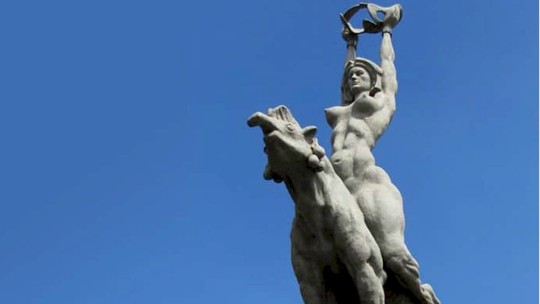
Let me start this by saying that, as far as my knowledge of Paganism and Polytheism as a whole goes, I’m what the internet witch community calls a “Baby Witch”. I’m stating this out of the gate because I know there will be lots of people, including witches who have more experience on the craft than me, who might decide to ignore what I have to say based on that fact alone, stating that I’m not knowledgeable enough to give my opinion about this.
Here’s the kicker: I’m a ‘baby witch’, yes, but I’m also a twenty-six year old Venezuelan woman. I’m an adult. I’m Latina. I’m a Christian-raised Pagan,but I’m also a Latinoamerican woman over all other things including that. I grew up on this culture, these are my roots. It is because of this background than I’m writing this post today.
Looking through the “Paganism” and “Witchcraft” tags of this website, I’ve seen a few posts throwing indigenous deities and spirits’ names around on lists alongside deties of open cultures. Yes, you can know better by doing your own research and not going by what just a random Tumblr user wrote on one post (as I hope its the case with everyone on this website), but the fact that pagan beginners are still getting fed misinformation is still worrisome to me.
There’s nothing like reading a so-called expert putting Ixchen (Maya), Xolotl (Nahuatl) and Papa Legba (Vodou) on the same damn list as Norse, Hellenic and Kemetic deities and tagging it on the tags aimed at beginners who might not know better to truly ruin your morning. I’m not mentioning user names here: If you know then you know.
To quote @the-illuminated-witch on her very good post about Cultural Appropriation:
“Cultural appropriation is a huge issue in modern witchcraft. When you have witches using white sage to “smudge” their altars, doing meditations to balance their chakras, and calling on Santa Muerte in spells, all without making any effort to understand the cultural roots of those practices, you have a serious problem.
When trying to understand cultural appropriation in witchcraft, it’s important to understand the difference between open and closed magic systems. An open system is one that is open to exchange with outsiders — both sharing ideas/practices and taking in new ones. In terms of religion, spirituality, and witchcraft, a completely open system has no restrictions on who can practice its teachings. A closed system is one that is isolated from outside influences — usually, there is some kind of restriction on who can practice within these systems.”
A counter-argument I’ve seen towards this when someone wants to appropiate indigenous deities and spirits is to use the “dead culture” argument: Extinct cultures are more eligible for use by modern people of all stirpes. It is a dead culture and dead religion. It would be one thing if some part of the culture or religion was still alive, being used by modern descendants, but the culture died out in its entirety and was replaced, right? They were all killed by colonization, they are ancient history now, right?
Example: “If white people are worshipping Egyptian deities now, then why can’t I worship [Insert Aborigen Deity Here]?”
To which I have two things to say:
Ancient Egypt’s culture was open and imperialistic, meaning they wanted their religion to be spread. This is why Kemetism is not Cultural Appropriation, despite what some misinformed people might tell you. Similar arguments can also be made for the Hellenic and the Norse branches of Paganism, both practiced by people who aren’t Greek/Norse.
Who are you to say which cultures are “dead” and which are not?
Religious practices such as Vodou and Santería certainly aren’t dead, not that it keeps some Tumblr users from adding Erzuli as a “goddess” on their Baby Witch post, something that actual Vodou practitioners have warned against.
Indigenous cultures such as the Maya and the Mapuche aren’t dead, despite what the goverment of their countries might tell you. The Mapuche in particular have a rich culture and not one, but two witchcraft branches (The Machi and the Kalku/Calcu). Both are closed pagan practices that the local Catholic Church has continuously failed to assimilate and erase, though sadly not for lack of trying:
“The missionaries who followed the Spanish conquistadors to America incorrectly interpreted the Mapuche beliefs regarding both wekufes and gualichos. They used the word wekufe as a synonym for ideas of the devil, demons, and other evil or diabolical forces. This has caused misunderstanding of the original symbolism and has changed the idea of wekufe right up to the present day, even amongst the Mapuche people.”
For context, the Wefuke are the Calcu’s equivalent of the Familiar, as well as reportedly having more in common with the Fae than with demons anyway.
This and other indigenous religions are Closed because it is wrong for foreigners to just come and take elements from marginalized groups whom are still fighting to survive and that they weren’t born into. To just approppiate those things would be like spitting in their faces, treating them and their culture like a commodity, a shiny thing, a unique thing to be used like paint to spruce up your life or be special.
I know some of you are allergic to the word “Privilege”, but on this situation there really ain’t a better word to explain it. You weren’t born here, you don’t know what it is like, you are only able to see the struggle from an outsider’s point of view.
If a belief or practice is part of a closed system, outsiders should not take part in it. And with how many practices there are out there which are open for people of all races, there is really no excuse for you to do it.
Why Colonization Is Not “Ancient History”
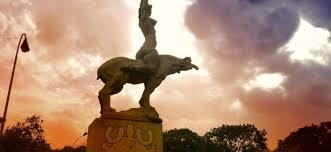
If you have kept reading all this so far, you are probably wondering “Ok, but what does Colonization has to do with any of this?”
The answer? Everything.
With the general context of culture appropriation out of the way, let me tell you about why the whole “dead culture” argument rubs me the wrong way: Here in Venezuela, we have a goddess called Santa Maria de la Onza, or Maria Lionza for short, whom’s idol statue I have been using to illustrate this little rant. If you happen to know any Spanish, you might recognize the name as a derivative of Santa Maria, aka the Virgin Mary, and you are mostly correct: Her true indigenous name is theorized to have been Yara.
And I say “theorized” because it is a subject of hot debate whether she was really ever called that or not: Her original name, the name by which she was adored and worshipped by our ancestors, might have been forever lost to history.
That’s the legacy of colonization for you: Our cultures were stolen from us, and what they couldn’t erase they instead tried to assimilate. Our ancestors were enslaved, their lands and homes stolen, their artwork and literary works destroyed: The Maya and the Aztec Empire were rich in written works of all kinds, ranging from poetry to history records to medicine, and the Spaniards burned 99% of it, on what is probably one of the most tragic examples of book burning in history and one that people rarely ever talk about.
People couldn’t even worship their own gods or pass their knowledge of them to their children. That’s why Maria Lionza has such a Spanish Catholic-sounding name, and that’s why we can’t even be sure if Yara was her name or not: The Conquistadors couldn’t steal our goddess from us, so they stole her name instead. Catholics really have a thing with trying to assimilate indigenous goddesses with the Virgin Mary, as they tried to do the same with the Pachamama.
On witchy terms, I’d define Maria Lionza as both a deity and a land spirit: Most internet pages explaining her mention the Sorte mountain as her holy place, but it is more along the lines that she is the mountain.
You’d think that, with Venezuela and other Latinoamerican countries no longer being colonies, we’d be able to worship our own deities including her, right?
As far as a lot of Catholics seem to think and act, apparently we are not.
The Catholics here like to go out of their way to shame us, to call us “cultists”, to ostracize us, with a general call to “refrain from those pagan beliefs” because they go against the Catholic principles. Yes, the goddess with the Catholic-sounding name, a name she happens to share with a Catholic deity, apparently goes “against Catholic principles”. You really can’t make this shit up. (Linked article is in Spanish)
This is just an act of colonization out of many, of not wanting to stop until the culture they want to destroy is gone. Don’t believe for a second that this is really their God’s will or anything like that, they are just trying to finish what years of enslavement and murder couldn’t. They might not be actively killing us anymore, but they still want us dead.
So no, colonization is not some thing that has long passed and now only exist on history textbooks: It is still happening to this day. It is by treating it as old history that they can keep doing it, and it is by pushing the narrative that our indigenous cultures are “dead cultures” that they try to erase our heritage.
Because we are not dead. We are still here, we are alive, we have survived and we’ll keep on surviving, and our gods and goddesses are not yours to take.
¡Chao! 🐈
#pagan#paganism#religion#culture#latino#latinoamerica#colonization#witch#baby witch#witchcraft#witchblr#Maria Lionza#colonialism#venezuela#brujeria#polytheism#witchcore#mapuche#vodou#nahuatl#history#cultural appropiation
2K notes
·
View notes